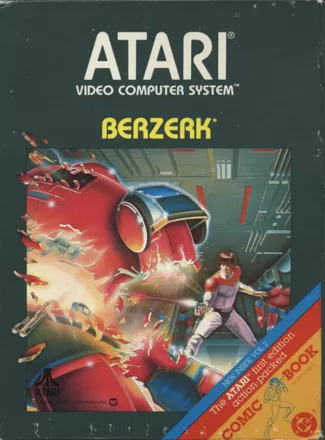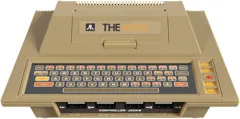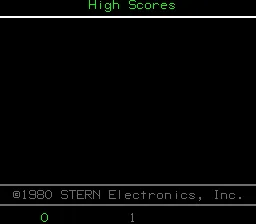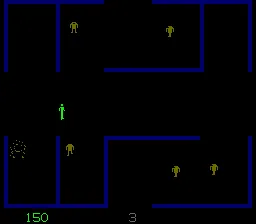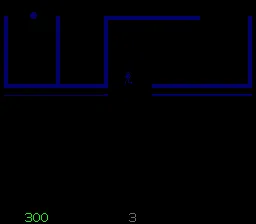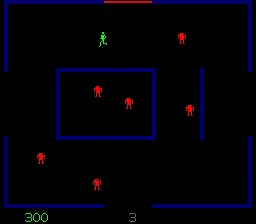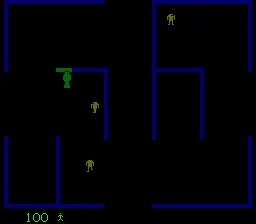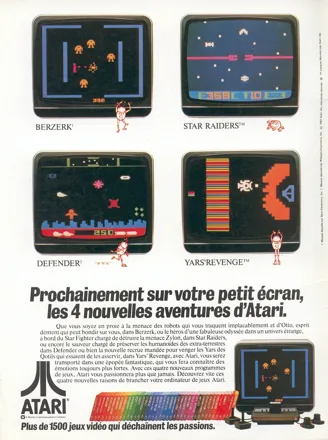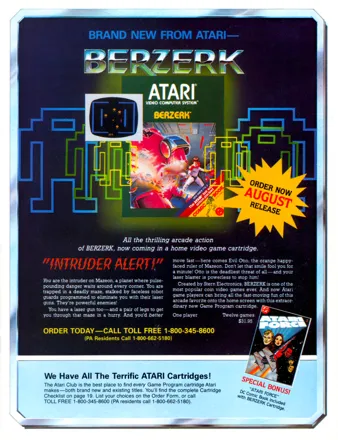Berzerk
Description official descriptions
You have been sent into a building infested with robots, and must do your best to clear it out. Each room has a number of walls through the middle, which restricts your movement. There will be a number of bad guys in the room - on early screens they may be immobile and not shoot at you, but after a few levels, they become capable of shooting in multiple directions. You can shoot at them in 8 directions, but can't shoot diagonally while moving. There are gaps at the side of each room, through which you exit, before or after clearing the room (there is a bonus for clearance). You get an extra life every 2000 points.
Groups +
Screenshots
Promos
Videos
Add Trailer or Gameplay Video +1 point
See any errors or missing info for this game?
You can submit a correction, contribute trivia, add to a game group, add a related site or alternate title.
Credits (Arcade version)
| Designed by | |
| Programmed by |
Reviews
Critics
Average score: 79% (based on 18 ratings)
Players
Average score: 3.6 out of 5 (based on 69 ratings with 1 reviews)
The Good
This is the line that is spoken from one of my favorite Atari 5200 games of all time. When I first loaded this game up, I was quite sure that the title read Berzerio due to the way the logo was created. This game was popular back in the day, it warranted a released on Atari's earlier 8-bit consoles, as well as the Vectrex. Out of these, I think the Atari 5200 version of Berzerk is the best one.
This game is standard shooter fanfare. You are in an endless maze, basically made up of rooms inhabited only by robots. You are equipped with a laser gun, which you use to shoot as many of them as you can. Take too long in a screen and Evil Otto will appear. If he comes in contact with you, you are electrocuted and lose a life.
Berzerk can be a difficult game. The further you proceed into the game, the more aggressive the robots become – with most of them shooting bullets that are harder to dodge. In this situation, you have to be careful what direction you are heading. Also, the game can be more frantic at times that you may crash into the electrified walls by accident. You can easily miss a robot, and when they fire at you, it may be too late for you to dodge their bullets.
The Atari 5200 does a great job at mimicking the graphics of the original arcade game. Both your character and the robots are animated nicely as they walk along. There are lights on every robot that rotate as long as they are alive. The system even mimics the stupidity of the robots. I found it very helpful watching them collide with each other, collide with the walls, or shoot each other. You score points for doing nothing, basically.
What I enjoyed in the game was the speech synthesis the 5200's POKEY chip is capable of. There are certain events that trigger it, such as waiting in a room long enough for Evil Otto to appear.
The robots sound exactly like robots, and their vocabulary ranges from “chicken” to “humanoid” to “intruder”. What word they use will depend on whether you were able to kill all robots before proceeding to the next room. They sound a lot meaner than in the arcade version, and they can use a different pitch for each word.
The controls are easy to master. You just push the joystick to go into a certain direction. The only downside is that in order to shoot, you have to face the direction you want to shoot.
The Bad
Regarding the speech synthesis, you won't hear anything like “Charge it”, “Attack the Humanoid”, or “Get the Chicken” while you are walking in a room, like what happens in the arcade version. It would have added to the atmosphere. Also, the graphics should have been a lot clearer. The walls should have looked like electrified barriers, for instance.
The Bottom Line
In conclusion, Berzerk is a great game of the 1980s, where the object is to go around a maze, shooting robots as you go. This gets difficult later on, as robots soon are able to fire at you. To ease the pain, some robots attack each other, ultimately leading to you scoring points for doing nothing. Although all versions of the game aren't bad, the Atari 5200 comes out on top for its speech synthesis, and you trigger it by doing certain actions such as getting yourself killed or leaving one of the room. There is no real ending to this game. It is basically a “score attack” game, where you can score as many points as you can without losing all your lives.
Atari 5200 · by Katakis | カタキス (43085) · 2013
Discussion
| Subject | By | Date |
|---|---|---|
| Differences between Berzerk and Robotron | Игги Друге (46636) | Jul 31, 2014 |
Trivia
Atari 8-bit port
The game is also in circulation for Atari 8-Bit computers, this is however believed to be the result of a leaked prototype and not an official release in the early '80s.
Board game
In 1983, Milton Bradley adapted this video game into a boardgame.
Comic book
Atari's 2600 release on Berzerk came with a comic book of Atari Force #2. Here is that comic at AtariAge.com.
Death
The coin-op version of Berzerk has the distinction of being associated with the first ever "video game death". Jeff Dailey, a 19-year old, suffered a heart attack in January 1981 shortly after playing the game.
References to the game
The famous phrases from the game "Intruder alert! Intruder alert!" and "Get the humanoid!" are sampled in the Futurama episode "Fear of a Bot Planet" where they are heard over a loudspeaker and by robots are chasing Fry and Leela. Also in The Simpsons episode "Homer Goes to College", Homer enters a residence where nerds are working at computers and one says "Intruder alert! Intruder alert!" while another says "Stop the humanoid!".
Song
Berzerk was popular enough to have a song inspired by it on the full-length Pac-Man Fever album - Goin' Berzerk.
Voices
The coin-op arcade version of Berzerk had digitally recorded dialogue. There were 16 spoken words stored on a small microchip, and they were put together in sequences to create complete sentences such as "Intruder alert! Intruder alert!" and "Destroy the humanoid!" This was technologically groundbreaking, but consider the cost. Almost a thousand dollars per word.
Awards
- Retro Gamer
- Issue 46 - #10 in the "Top 25 Atari 2600 Games" poll
Information also contributed by Guy Chapman, LepricahnsGold, Maw, PCGamer77, Pseudo_Intellectual and Scaryfun
Analytics
Related Sites +
-
The International Arcade Museum
extensive information about the arcade game machine -
Wikipedia
free Encyclopedia entry
Identifiers +
Contribute
Are you familiar with this game? Help document and preserve this entry in video game history! If your contribution is approved, you will earn points and be credited as a contributor.
Contributors to this Entry
Game added by wanax.
Atari 5200 added by RKL. Arcade added by Pseudo_Intellectual. Antstream added by lights out party. Vectrex added by Servo.
Additional contributors: Shoddyan, Martin Smith, Trypticon, Patrick Bregger, ZeTomes.
Game added April 10, 2003. Last modified January 9, 2025.


